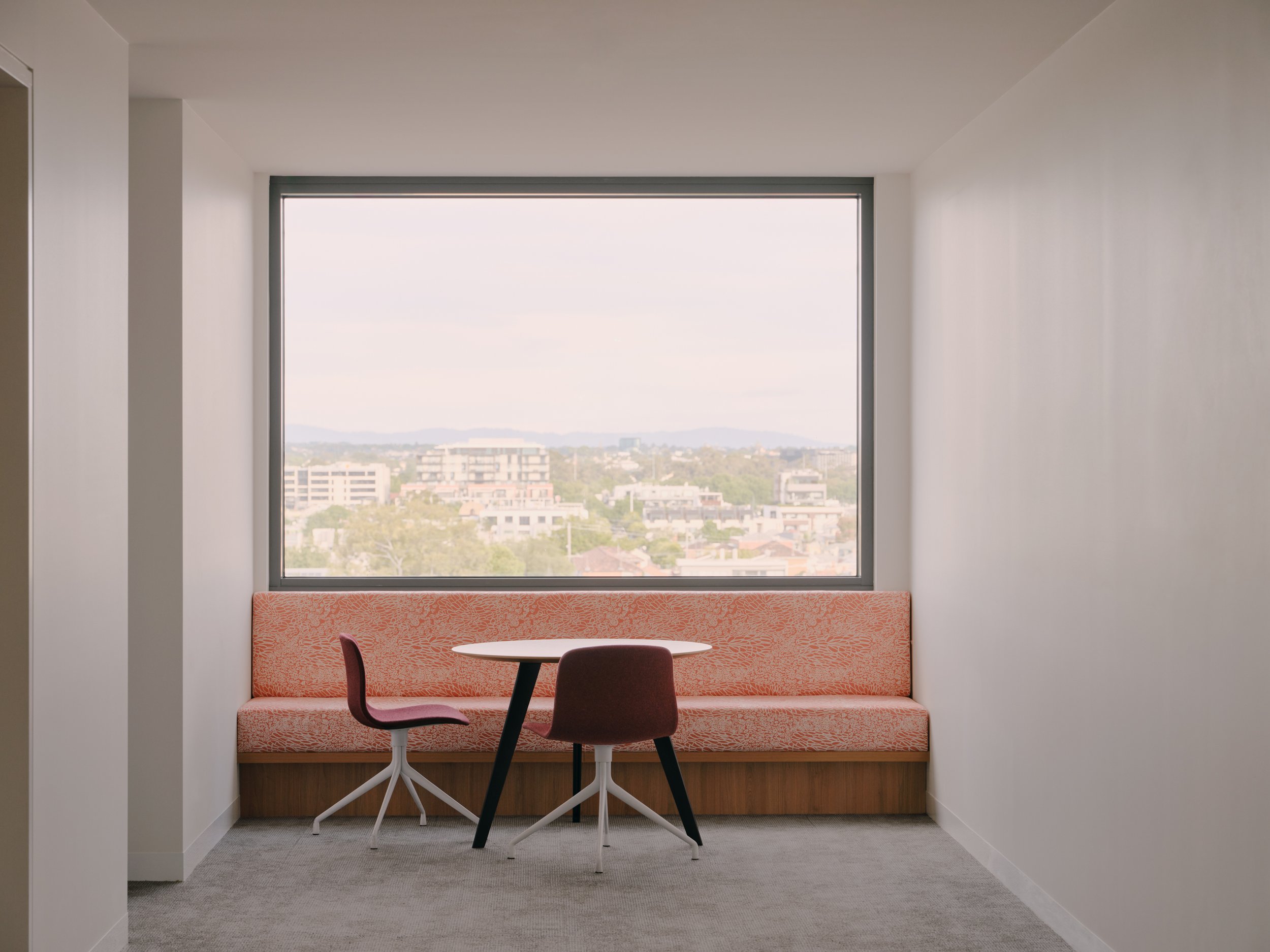John McIldowie: Melbourne Indigenous Transition School
April Jones’ Rainbows in ‘Pindan’ [banquette seating and ottoman], Elizabeth Kandabuma’s Mud Ripples in ‘Speargrass’ [upholstered wall panelling in alcove] and Annunciata Nunuk Wilson’s Syaw (Fish Net) in a custom rust colour [wallpaper], at Melbourne Indigenous Transition School’s new boarding house in Richmond, Naarm (Melbourne). Photo: Tom Ross.
Melbourne Indigenous Transition School (MITS) supports young First Nations people from remote top-end and regional Victorian communities as they pursue away-from-home schooling in Melbourne. Each year, 22 new arrivals board at one of seven MITS boarding houses and attend school at a Year 7 class inside the grounds of the Richmond Football Club. Once the year is complete, alumni are privy to further boarding options and the MITS Pathways Program, which creates opportunities for students to study at leading partner schools throughout Melbourne.
Previously, this has all taken place in MITS’ historic, refurbished facilities on Wurundjeri land. More recently, an exciting new building has heralded a new chapter for the school and its students. Propelled by a vision to provide students with a fitting home away from home, the project was led by architecture practice, McIldowie Partners. Here, McIldowie Director John McIldowie, discusses this special project, including the selection of some Willie Weston fabrics and wallpapers throughout the interiors.
The school’s built environment has developed significantly over the past few years, evolving from classrooms at the Richmond Football Club and boarding house on Richmond Hill to the recent refurbishment of three boarding houses at 139 Richmond Terrace, 364 Church Street, and 371 Church Street. Given the core functions of the school, how important is the design and fit out of these spaces?
The project is home to 40 Indigenous students from remote communities across the Northern Territory and Victoria. This brings with it a significant cultural shift and an isolation that comes with leaving home for the first time. So creating safe spaces for students, where they can remain strong in their culture while surrounded by their peers, is critically important.
As you’ve noted, the project is one of a series of MITS boarding facilities on Richmond Hill and this project was envisaged as a hub for all MITS students, as well as a home to some. So fostering a sense of belonging and community for students as a broader network was an essential part of this project. That’s about connections here in Melbourne, but also about a connection with the most important people for the students – their families back home – which is critical to ensuring students succeed.
“Ultimately, the MITS program and people are so inspiring that the value of the project is really about creating a platform for the team at MITS to support their students in their journeys, here in Melbourne and beyond. ”
Mud Ripples in ‘Wild Red Apple' features in custom upholstery in break out areas throughout the building. Photo: Tom Ross.
The boarding house at 371 Church Street is the first building the school has been designed and constructed from scratch. What were the overarching goals for this project, and can you describe the design intent?
The projects sit amongst a collection of existing MITS Boarding Facilities across Richmond, along with their learning spaces at Yarra Park, at the home of the Richmond Football Club. The significance of this is that each of the existing boarding houses were refurbishment projects within monastic and colonial buildings. In this project, the building could be an expression of MITS, its values, aspirations and people for the first time. This opportunity was the driving force of the design.
In response to this, it was important that the building had a dialogue between the place, the country on which it sits and the diversity of the MITS community, whose students come from remote communities across the Northern Territory and Victoria.
To explore this, we worked closely with a cultural heritage team to uncover the history of the site and its surrounding context. Of nearby significance is Yarra Park, home to MITS’ school and a place of Aboriginal cultural heritage with a series of sacred trees on the Victorian Aboriginal Heritage Register. So, the design approach was to place the building within the cultural heritage of its context, while establishing a new history for the students who call MITS home.
“... it was important that the building had a dialogue between the place, the country on which it sits and the diversity of the MITS community ...”
Describe the final design.
The design is built around three key design strategies that respond to the design approach mentioned.
First, to set the building within a reclaimed native landscape to connect students to Country and the broader history of the area. Second, to establish a street-facing statement of MITS’ identity, set back from the street to provide a generous landscape buffer and two stories in height to sit in scale with the streetscape. And third, to place a harder-working boarding facility to the rear of the site, set over three levels and connected to courtyards to the north and south at ground level, and a roof terrace at level two occupying the setback.
Functionally, ground floor spaces house administration spaces as a signature of welcome and entry, with key student social spaces occupying the rear portion of the site.
Levels one and two include a mix of dorm rooms, with a collection of study and social spaces set amongst the street trees to draw in dappled light. A rooftop terrace sits above the west-facing component of the site, activating the building setback to capture views out across the city, while creating gathering spaces for students.
Rainbows in ‘Pindan’ by April Jones was selected based on where some of the students are from. Photo: Tom Ross.
Rainbows in ‘Pindan’
April Jones’design references the rainbows that appear at the end of the wet season and is part of our Fitzroy Crossing Collection.
It has been said that the building has allowed the school to tell the stories of students and their cultures through the celebration of art from across our communities - can you tell us how this approach is evident in final interior spaces?
Design elements for the interiors are drawn from each of the six regions MITS students call home with fabrics, lighting, wallpaper, way-finding graphics and more storytelling of those places to connect students with their home away from home.
One of our favourite examples of this is a painting that hangs in the foyer by Lorraine Kiddindi White’s father, Freddie Nadjamerrek, which tells the Lightning Dreaming story of Namarrkon, who uses the axes on his feet, elbows and knees to make lightning and thunder. MITS uses this as a reminder to students to create their own lightning here in Melbourne.
We understand that Senior Wurundjeri Elder Uncle Colin Hunter provided cultural guidance and advice through the design and delivery of the building. Can you tell us more about this process and how it helped to achieve the final result?
MITS led a consultation process with Uncle Colin Hunter throughout to review the design. As an example, the Dreamtime story which adorns the façade is unique to Lorraine Kabbindi White’s family; Lorraine is a member of the MITS community. Uncle Colin's blessing that this was an appropriate statement on Wurundjeri land was essential.
“The Willie Weston fabric and wallpaper were an obvious choice, not just as a continuation of the storytelling narratives, but as a feature interior element that reinforced our design approach...”
Mud Ripples in 'Wild Red Apple' by Elizabeth Kandabuma is from our Bábbarra Collection, seen here at MITS new boarding house in a photograph by Tom Ross.
Four Willie Weston designs feature in the space – Rainbows ‘Pindan’ and Mud Ripples ‘Wild Red Apple’ and ‘Speargrass’ upholstery fabrics, and Jilamara ‘Stone’ and Syaw (Fish Net) in a custom rusty red colour as wallpapers. Can you tell us about the selection process for these fabrics and wallpapers?
The material selection internally continues our desire to connect the building with a reclaimed native landscape inside and out.
The Willie Weston fabric and wallpaper were an obvious choice, not just as a continuation of the storytelling narratives, but as a feature interior element that reinforced our design approach, with beautiful native flora and abstracted elements. Used throughout social and study spaces, they add an incredible texture to the interiors and are authentic to our design vision, and to the students' culture.
These textile designs work in unison with wall hangings, lampshades and other artwork by First Nations designers, artists and craftspeople, including First Bees – a considerable work by MITS community member, Lorraine Kabbindi White – and Pinikita by Edwina Green, as part of the building’s exterior. Can you share a little bit about these other elements and how they impact students, staff and visitors on a daily basis?
The most striking example of this is the façade, which we envisaged as a canvas for storytelling, cultural celebration and exchange. Working in collaboration with Indigenous artist Lorraine Kabbindi White, the façade tells the Dreamtime story of the First Bees. This is a story of transformation, where men’s spirits turned into bees, as analogous to the young boys and girls in the building house turning into men and women.
Laser-cut perforated screens wrap the façade in this story as a landmark statement for MITS, its students and the community.
Another example is the poured paving artwork to the south courtyard by Trawlwoolway artist Edwina Green called Black Man’s Map, which is derived from topographic rain maps, where mountains, rivers and elevation changes impact how indigenous people have navigated and engaged with landscapes. Each of these examples, along with numerous other examples internally, aim to create an environment where students feel a sense of ownership, belonging and connection to culture.
Willie Weston products features in the new MITS dormitory, including Syaw (Fish Net) wallpaper by Annunciata Nunuk Wilson in a custom colour way [front] and Mud Ripples fabric in ‘Speargrass’ by Elizabeth Kandabuma [back, in alcove]. Photo: Tom Ross.
Syaw (Fish Net)
Annunciata Nunuk Wilson’s design evokes nets traditionally woven by the women and men of Peppimenarti to capture fish and crayfish.
“Each of these examples, along with numerous other examples internally, aim to create an environment where students feel a sense of ownership, belonging and connection to culture. ”
Finally, are there any other insights or highlights you would like to share?
The project was designed and built through COVID, which had its own challenges, particularly with rapidly rising construction costs. But the generosity of head contractor Kane, the consultant team, sub-contractors and suppliers who provided design, labour and materials at significantly reduced rates, is one of the hallmarks of this project. It simply wouldn’t have been possible without the efforts and partnership approach of all parties, which guided by MITS’ vision, creating an amazing atmosphere around the project that ultimately led to its success.









